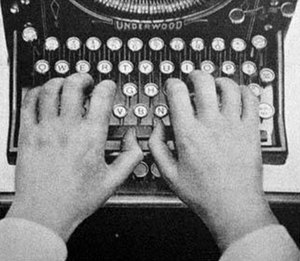QWERTY (pronounced /ˈkwɜrti/) is the most used modern-day keyboard layout on English-language computer and typewriter keyboards. It takes its name from the first six characters seen in the far left of the keyboard's top row of letters. The QWERTY design was patented[1] by Christopher Sholes in 1874 and sold to Remington in the same year, when it first appeared in typewriters.
History and purposes of QWERTY(the keyboard layout)
The QWERTY keyboard layout was devised and created in the early 1870s by Christopher Sholes, a newspaper e ditor and printer who lived in Milwaukee.
ditor and printer who lived in Milwaukee.
With the assistance of his friends Carlos Glidden and Samuel W. Soule he built an early writing machine for which a patent application was filed in October 1867.[2] His "Type Writer" had its printing point located beneath the paper carriage, invisible to the operator. Consequently, the tendency of the typebars to clash and jam if struck in rapid succession was especially serious, because the typist could only discover the mishap by raising the carriage to inspect what he had typed.[3]
Sholes struggled for the next six years to perfect his invention, making many trial-and-error rearrangements of the original machine's alphabetical key arrangement in an effort to reduce the frequency of typebar clashes. Eventually he arrived at a four-row, upper case keyboard approaching the modern QWERTY standard. In 1873 Sholes' backer, James Densmore, succeeded in selling manufacturing rights for the Sholes-Glidden "Type Writer" with E. Remington and Sons, and within a few months the keyboard layout was finalised by Remington's mechanics. Their adjustments included placing the "R" key in the place previously allotted to the period mark, thus enabling salesmen to impress customers by pecking out the brand name "TYPE WRITER" from one keyboard row. Vestiges of the original alphabetical layout remained in the "home row" sequence DFGHJKL.[3]
The QWERTY layout depicted in Sholes' 1878 patent includes a few differences from the modern layout, most notably in the absence of the numerals 0 and 1, with each of the remaining numerals shifted one position to the left of their modern counterparts. The letter M is located at the end of the third row to the right of the letter L rather than on the fourth row to the right of the N, the letters C and X are reversed, and most punctuation marks are in different positions or are missing entirely.[1] 0 and 1 were omitted to simplify the design and reduce manufacturing and maintenance costs; they were chosen specifically because they were "redundant" and could be recreated using other keys. Typists who learned on these machines learned the habit of using the lowercase letter L for the digit one, and the uppercase O for the zero. The exclamation point, which shares a key with the numeral 1 on modern keyboards, could be reproduced by using a three-stroke combination of an apostrophe, a backspace, and a period. The 0 key was added and standardized in its modern position early in the history of the typewriter, but the 1 and exclamation point were left off some typewriter keyboards into the 1970s.[4]
There was no particular technological requirement for the QWERTY layout,[clarification needed] since at the time there were ways to make a typewriter without the "up-stroke" typebar mechanism that had required it to be devised. Not only were there rival machines with "down-stroke" and "frontstroke" positions that gave a visible printing point, the problem of typebar clashes could be circumvented completely: examples include Thomas Edison's 1872 electric print-wheel device which later became the basis for Teletype machines; Lucien Stephen Crandall's typewriter (the second to come onto the American market) whose type was arranged on a cylindrical sleeve; the Hammond typewriter of 1884 which used a semi-circular "type-shuttle" of hardened rubber (later light metal); and the Blickensderfer typewriter of 1893 which used a type wheel. The early Blickensderfer's "Ideal" keyboard was also non-QWERTY, instead having the sequence "DHIATENSOR" in the home row, these 10 letters being capable of composing 70% of the words in the English language.[3]
In the QWERTY layout many more words can be spelled using only the left hand than the right hand. In fact, thousands of English words can be spelled using only the left hand, while only a couple of hundred words can be typed using only the right hand. This is helpful for left-handed people.[5]

